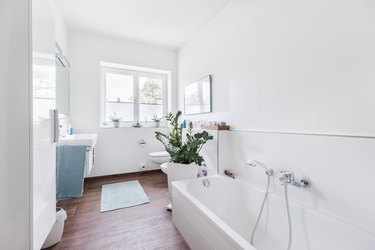
While it may be more common these days to convert a bathtub into a shower, there are many reasons for doing just the opposite and changing a shower into a tub. Some homes do not even have bathtubs, and their owners may want to have at least one in their home. Others may need to add an extra tub, whether it be for their children, for an in-law suite or for a rental property. No matter the reason, performing this bathroom renovation on your own could save you a considerable amount of money.
Can My Shower Be Converted Into a Tub?
Video of the Day
Walk-in showers are easier to convert than smaller ones. Standard bathtubs usually measure 60 x 30 x 14 inches, so measuring the shower area is the first step. It may be possible to change the shower into a tub-and-shower combination if desired. There are a number of ways to add a tub to your bathroom.
Video of the Day
You may want to demolish the entire shower area and start from there, but it may also be possible to keep the existing apparatus and move a tub into the area. In order to do this, you will need to build a new wall that will close in the shower. Some of the tools and supplies you will need include 2x4 wood pieces, a drill and concrete backerboard. Be sure to turn off the water supply while you are working.
Building the New Wall
Prepare a rectangular frame with the wood and add support boards that are positioned every 8 to 10 inches. Screw this frame together and attach it to the existing walls and floor. Attach your concrete backerboard to the frame.
Many homeowners choose to tile this wall to avoid needing to purchase a tub or shower kit. Begin tiling the new wall by laying down tile adhesive at a 45-degree angle, approximately 1/16 inch thick. Place the first tile and then use spacers as you continue along.
Now, it is time to grout the new wall. Prepare the grout if necessary (some grout is premixed) and use a rubber grout float to spread it into the grooves. Wipe away any excess grout immediately with a trowel or other grout tools and then allow the grout to set. Once the grout is completely dry, apply caulk along the edges where the tile meets the walls and shower edges.
Alternatives for a New Tub
If the shower is too small to accommodate a tub, you can use a jackhammer to demolish the tiles and shower walls. You may need to install a new wall, which would require putting up drywall. You may want to tile the entire area or purchase a ready-made tub to install. This type of kit will include installation instructions and will explain the additional tools you will need.
If you are at all unsure about how to proceed with this sort of installation, it's best to consult a professional. Bathrooms have both plumbing and wiring hidden within their walls, and you don't want to risk disconnecting either inadvertently, or worse, creating an electrocution hazard by having both accessed at once.